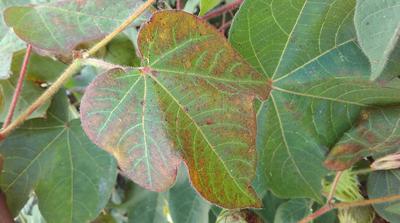Leaf Reddening of Cotton
Leaf Reddening
Other
In a Nutshell
- Leaf margins turn red first, later discoloring the whole leaf.
- Wilting and reddening of stems.
- Leaf and fruit shedding.
- Stunted growth.
Can also be found in
Symptoms
The actual reddening of the leaves can vary slightly depending on the cause and the crop stage. In most cases, leaf margins turn red first and the discoloration later spreads to the rest of the blade. Other symptoms may include wilting, reddening of stems, poor or no boll development, leaf and fruit shed and stunted plants. During senescence, the discoloration is a natural process that can usually be observed throughout the whole field. Besides nitrogen deficiencies, leaf reddening can also be caused by overexposure to direct sunlight, cold temperatures and wind damage. In that case, the discoloration affects single leaves rather than the whole field.
Recommendations

Organic Control
Depending on stress and growth stage, the application of organic fertilizers can be beneficial for the plant. Biological control is not necessary if the leaf reddening starts late in the season or if the process is triggered by physical factors.

Chemical Control
Always consider an integrated approach with preventive measures and biological treatments if available. There is no chemical control available for leaf reddening in cotton crops. A good supply of farmyard manure, a judicious irrigation program and balanced fertilization will help to avoid the problem. If happening early in the season, amendments with nutrients may help to solve the problem. If symptoms start around the same time as the opening of the first bolls, no measures need to be taken.
What caused it?
Symptoms can be caused by several abiotic factors such as water, continuous temperature stress or soil poor fertility. Some varieties or hybrids are more susceptible than others. The reddening is due to the increase in a red pigment called anthocyanin and a decrease in the green pigment chlorophyll in leaves. A cause can be the death of rootlets that reduces the ability of the plant to actively take up water and nutrients. During senescence, this process is natural and has no negative effect on the yield. Other causes early in the season may be the deficiency of nitrogen, phosphorus and potassium (magnesium does not seem to be involved). Furthermore, overexposure to sunlight, wind and cold temperatures can also trigger discoloration.
Preventive Measures
- Plant at the recommended time to avoid high soil temperatures during fruiting.
- Check the best distance between plants.
- Use cotton varieties resistant to abiotic stress.
- Make sure to have an adequate manuring of the soil.
- Protect the crops from physiological stress like direct wind damage.
- Plan a judicious irrigation according to the plant's needs.
- Monitor soil nutrients and apply balanced nutrient management practices.
- After harvest plow deep to mix soil.



